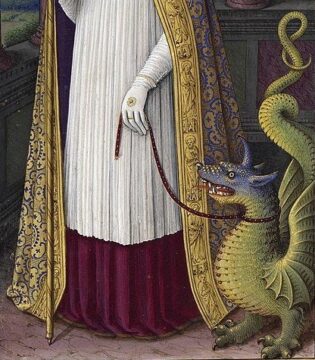by Eleni Petrakou

During this Chinese New Year celebrations, this columnist was very surprised to realize that what dragons were is not really common knowledge.
Are you one of those people who don’t know? I’m glad you are here. Already know? A refresher is always pleasant on this particular topic.
Thinking of it, I was probably spoiled. I happened to get exposed to the answer before I thought of the actual question; all by reading Carl Sagan’s stunning “The Dragons of Eden” at a young age.
But, notwithstanding, I mean, what could dragons be other than dinosaurs.
*
For millennia, unrelated civilizations around the globe have been painting dragons at every chance they get. Ever since we found out about dinosaurs we’ve been doing the same with them. Kids are enamored. Toys, cartoons, grown-up science articles abound. It’s impossible to go a single day without a dinosaur, in some artistic form or other, entering our field of vision. Today I saw three. Plus two dragon tattoos.
The obvious physical similarity between the two creatures probably renders any further arguments redundant. (But it’s interesting to add that one ingredient in traditional chinese medicine used to be dragon bones; and it was powdered dinosaur fossils.) The question is not “whether” but “how on earth”. How was it possible for humankind to retain the image of creatures separated from it by tens of millions years?
Although I don’t know the answer, “The Dragons of Eden” looked at a few more hints of this peculiar survival in our species’ collective memory bank. They mostly have to do with snakes, the “evil lizards’” direct descendants.
*
For one, there is the global sound for asking for silence. Granted, snakes are a common threat to life in the countryside; but probably not so outstanding as to justify this use of their sound by all humans. Pair that with the fear of snakes, found to be one of the few pieces of concrete information humans are born with.
Then, there is that mind-boggling myth of the ousting from paradise in Genesis, where, among other things, the snake is proclaimed humanity’s number one enemy. And is made to move on its belly from that point on.
Sagan speculated on that myth echoing the mental evolution of mammals as a possible result of the struggle for survival against serpents. (Think attainment of knowledge, pain in childbirth from that point on – both actual results of the growth of the brain starting around the dragons’ era).
Similar notions show up in the greek myth of Cadmus, where civilization starts with people grown from the teeth of a slain –you guessed it– dragon. And I expect that more examples can be found in other mythologies.
*
Coming back to the few pieces of concrete information humans are born with, these include the fear of falling and the grasp reflex. Both must have developed at some point, and this could have reasonably been when their ancestors lived in and moved between high trees. Did the images of dinosaurs survive through the eons as a similarly inherited piece of knowledge?
“The Dragons of Eden”, subtitled “Speculations on the evolution of human intelligence”, is a phenomenal book not only on the mysteries of the brain but, it could be said, on the joy of scientific research. Among the many other topics it touches on is dreaming. It accepts the psychoanalytic explanation but also surmises that, as we progress deeper into sleep each night, more ancient parts of the brain get a chance to play; and graces us with the quote, “Late at night, when it is very still and the obligatory daily dreams have been dreamt, the gazelles and the dragons begin to stir”.
Please contemplate the beauty of this mystery of evolution and enjoy the rest of the Year of the Dinosaur.
